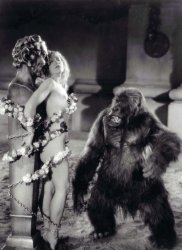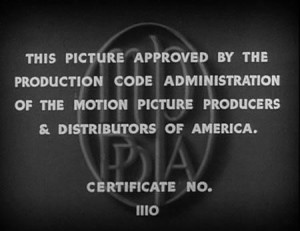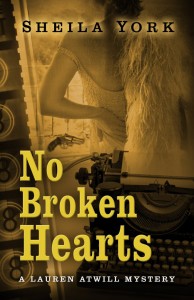 Relevant History welcomes Sheila York who, after a successful career in TV and radio, began writing novels combining her love of mystery, history and the movies. Her series features screenwriter Lauren Atwill (and her lover, private detective Peter Winslow) chasing killers in the last hurrah of the Great Golden Age of Film. Sheila’s first novel, Star Struck Dead, won a Daphne du Maurier award. Lauren’s latest adventure, No Broken Hearts, was praised by Charles Todd: “If you love a terrific mystery, York is a must read!” To learn more about her and her books, visit her web site, and follow her on Facebook and Twitter.
Relevant History welcomes Sheila York who, after a successful career in TV and radio, began writing novels combining her love of mystery, history and the movies. Her series features screenwriter Lauren Atwill (and her lover, private detective Peter Winslow) chasing killers in the last hurrah of the Great Golden Age of Film. Sheila’s first novel, Star Struck Dead, won a Daphne du Maurier award. Lauren’s latest adventure, No Broken Hearts, was praised by Charles Todd: “If you love a terrific mystery, York is a must read!” To learn more about her and her books, visit her web site, and follow her on Facebook and Twitter.
*****
Censorship has a long, complicated history in America. Don’t worry, I’m going to spare you that.
Instead, we’re going on a short, high-points tour of the censorship of American film. Ah, maybe you didn’t know movies were once heavily censored. You thought in all those Golden Age films when passion overcame lovers, they just naturally pressed their cheeks together and faced the camera rather than locking lips. And never noticed the lack of cleavage and that nobody got away with a crime.
There were, you see, rules. They were called the Production Code, and they controlled the content of American films from 1934 until replaced with an early form of our ratings system in the late 1960s (following years of rebellion by filmmakers and audiences).
OK, here’s our first stop: the very first line of the Production Code.
No picture shall be produced which will lower the moral standards of those who see it.
Wow. You’ve got to wonder what led to that.
The power of silents
The impact of silent films is hard to imagine today, in an age of instant communication, but they were our first shared national cultural experience. Across the country audiences thrilled to the same movies with the same stars, and devoured the same fan magazines (a new sensation) awash in stories about them. American film stars were the most famous people in the world – Fairbanks, Swanson, Chaplin, Pickford, Keaton, Valentino.
However, silent films had no rules, and pretty quickly communities and religious groups worried about movies’ influence, and what some filmmakers were up to: flouting conventional morality, ridiculing authority, reveling in sexual innuendo, and joking about drunkenness and drugs.
By 1921, five states—Pennsylvania, Ohio, Maryland, Kansas, and New York—had established censorship boards. With nearly 30% of America’s ticket sales, they had the muscle to ban individual films in their states or delete scenes they deemed inappropriate. Some cities followed suit. After traveling through a few towns, a film could be rendered incomprehensible.
Some citizens thought the federal government should control films.
We can police ourselves. Yeah, sure.
In 1922, the major studios formed the Motion Picture Producers and Distributors of America and picked Will Hays, a man well connected in Washington, to run it. The best the MPPDA could do was create a long list of content guidelines, “The Don’ts and the Be Carefuls”. Compliance was voluntary.
The sound and more fury
 In the late 1920s, films began to speak; reformers could be shocked by what they saw and heard. And they saw and heard plenty. When the Depression cut into box office, studios discovered sex and violence could sell tickets. Tommy-gun-toting gangsters ruled in films like Little Caesar. Mae West brought her shocking double-entendres to Hollywood.
In the late 1920s, films began to speak; reformers could be shocked by what they saw and heard. And they saw and heard plenty. When the Depression cut into box office, studios discovered sex and violence could sell tickets. Tommy-gun-toting gangsters ruled in films like Little Caesar. Mae West brought her shocking double-entendres to Hollywood.
 And Mr. DeMille made a movie called—I’m not kidding—The Sign of the Cross. Orgies, Christians sacrificed, Claudette Colbert bathing naked. The theory seems to have been that this would demonstrate Roman degeneracy.
And Mr. DeMille made a movie called—I’m not kidding—The Sign of the Cross. Orgies, Christians sacrificed, Claudette Colbert bathing naked. The theory seems to have been that this would demonstrate Roman degeneracy.
Maybe Mr. De Mille just couldn’t control himself.
Hey, what about a Code? It was already there.
The Code was written in 1929 by a priest named Daniel Lord and Martin Quigley, a movie-industry-publication owner (and devout Catholic). Quigley (and many others) lobbied for its adoption. Studio heads agreed, but the administration they created in 1930 had only the power of persuasion.
In response, the Catholic Church developed its own ratings system. Then came their Legion of Decency. Its pledge’s first line gives you some idea of how the Church felt: I wish to join the Legion of Decency, which condemns vile and unwholesome moving pictures.
 Finally the MPPDA ceded full power to control content. Beginning 1 July 1934, films could not be distributed without the Code seal of approval. The Code finally had teeth. Joe Breen, a public relations man and movie lover with excellent Church connections, ruled the Code Office for the next twenty years.
Finally the MPPDA ceded full power to control content. Beginning 1 July 1934, films could not be distributed without the Code seal of approval. The Code finally had teeth. Joe Breen, a public relations man and movie lover with excellent Church connections, ruled the Code Office for the next twenty years.
His office screened books/plays whose rights the studios were considering purchasing. Studios submitted draft scripts for early advice. While filmmakers could negotiate (and the Code Office would sometimes change its mind), they had to get approval of their shooting scripts and the final cuts of their films.
So this, briefly, is how we ended up with movies striving not to lower moral standards, in which adultery could never be justified and marriage was sacred. No nudity or suggestive costumes. No excessive kissing or drinking. Justice must triumph.
Here are a few of my favorites from the 1940s, the decade in which my heroine must grapple with the Code, with some Code notes you might enjoy.
The Best Years of Our Lives (46): The Code Office wanted all drinking eliminated. Try handling that when your script has a crucial bar-hopping scene.
The Big Sleep (46): Notice how much sexual innuendo they get away with in the bookstore.
The Blue Dahlia (46): In the original script, the wounded ex-Navy flyer (William Bendix) was the killer. Shown the script, the Navy objected. The movie got a new killer.
Casablanca (42): The censors forbade any overt indication that Captain Renault exchanged visas for sex; notice Strasser must draw his gun before Bogart can fire.
Crossfire (47): The murder victim in its source novel, The Brick Foxhole, was homosexual. Breen called it “completely unacceptable.” The victim became Jewish. The writer made sure to give him a girlfriend.
Double Indemnity (44): The poignant ending was made possible because the Code Office forbade any portrayal of an execution in early notes.
The Lady Eve (41): Check out Stanwyck/Fonda nuzzling in her stateroom. Pretty hot, but notice she’s on a chaise and he’s on the floor.
The Maltese Falcon (41): The Code Office forbade the suggestion of Spade’s affair with his partner’s wife (though it’s still crystal clear).
Notorious (46): It’s amazing this movie ever got made: a woman of loose morals as the heroine? Screenwriter Ben Hecht is my hero.
Rebecca (40): No one can get away with murder. The book’s resolution changed.
*****
 A big thanks to Sheila York. She’ll give away hardback copy of No Broken Hearts to someone who contributes a comment on my blog this week. I’ll choose the winner from among those who comment by Friday at 6 p.m. ET. Delivery is available in the U.S. only.
A big thanks to Sheila York. She’ll give away hardback copy of No Broken Hearts to someone who contributes a comment on my blog this week. I’ll choose the winner from among those who comment by Friday at 6 p.m. ET. Delivery is available in the U.S. only.
**********
Did you like what you read? Learn about downloads, discounts, and special offers from Relevant History authors and Suzanne Adair. Subscribe to Suzanne’s free newsletter.

Lower the moral standards of those who see it? Now that’s a statement that is open to just anybody’s interpretation, huh? What a fascinating time period–so like our own. The series sounds fascinating; off to buy the first one now.
The series sounds fascinating; off to buy the first one now.
Thanks! I too am fascinated by that first line of the Code. How do you judge, let alone control, the effects of what you put on the screen? The Code’s general principles are very strict, but what ended up on the screen was sometimes quite different, because there was back-and-forth between the filmmakers and the Code Office, which understood Hollywood was after all in the business of making films. But their restrictions strike us today as sometimes ludicrous. They carried the idea that justice must triumph to the extent that nothing was allowed that could be considered “advice to criminals.” In Double Indemnity, a line in which Fred MacMurray advised Barbara Stanwyck to “put some gloves on” before she handles a document was vetoed, and he instead says simply, “Be careful.”
Intriguing–now I have to watch some of those movies again with this knowledge in mind. Thanks!
Thanks, Cindy. To Have and Have Not might be a place to start, if you like Bogart and Bacall. You know she’s a woman who, shall we say, has lived by her wits, but it’s obliquely presented. ANY adult understands though.
Fascinating!! What was the process like, I wonder? Did a movie’s script receive some sort of official review first, before filming began? Or was there a point, perhaps during editing, when a film would be evaluated? Did the filmmakers have any recourse if they felt changes were draconian…?
Linda, yes, there were negotiations, which could go on for months. Filmmakers almost always presented early script treatments to the Code Office for advice, and the Code Office would tell them where they were skating on thin ice, and would make suggestions for changes. In this way, the filmmakers knew how to reach a final script that would be approved, with as few final revisions as possible. During these negotiations, the Code administrators could be persuaded to change their minds. The most stunning example to me is Notorious. The administrators basically allowed the story of a woman with a past. Sexual sin without serious consequences? I think that movie only got made the way it did because it had a top director (Hitchcock), two huge stars (Bergman and Grant) and one of the most successful screenwriters (Hecht). By the way, despite all the negotiations on this side of the Atlantic, Notorious was banned in Ireland.
How long did this last… ? I’d love to know how it ended up being reversed. Perhaps another blog… 😉
Linda, maybe we can thank the Italians — and audiences who wanted more realistic portrayals of adult themes after World War II — for the gradual erosion of the power of the Code. Italian cinema in particular made strong influential inroads in larger American cities beginning in the late 40s. TV also contributed. The American film industry was nearly brought to its knees by TV, so there was incentive to give moviegoers something they couldn’t see on TV. Filmmakers became able to distribute films in theaters even if they didn’t have the seal of approval. By the 60s, it was clear the Code wouldn’t work for Hollywood anymore. In 1968, an early form of our ratings system replaced it.
The Sign of the Cross was one of the lewdest movies I’ve ever seen. DeMille didn’t get that “Gospel” is supposed to mean good news. His Christians were the worst suffering sourpusses imaginable. (But, what do you expect from DeMille? Don’t get me started about his private life.) As for Notorious, Ingrid Bergman’s abandoned character was nearly poisoned to death before the end. Surely that would placate the Hollywood haters of loose women. (Leave me out of the book drawing, I have No Broken Hearts, and an excellent read it is.)
We almost got a spoiler alert there. But whatever jeopardy Bergman’s character got into, you knew they wouldn’t bump off the luminous Ingrid. ALTHOUGH…Ben Hecht’s first draft of the screenplay did kill off the heroine, possibly because he knew the wages of sexual sin in Hollywood films. Joe Breen didn’t think dying a heroine spying for her country offset the fact that she had an active sexual history. Hecht turned the focus on her drinking in later drafts as a code for looseness, so when she asks Grant at one point (after she hasn’t had a drink a several days) whether he thinks someone can reform, she ain’t talkin’ about booze.
Oh and thanks for the compliment about No Borken Hearts, Kate. See what happens when I start talking movies… I forget everything else.
And I can’t even spell the name of my book. No Broken Hearts
Thank you for the opportunity to win this fascinating book. Good luck to everybody but i hope i win
I do find it a little bit comical that you spelled your phone book title wrong. Lol
Sorry I can’t talk and you can’t spell… Lol
Own not phone… Lol
Hahaha. My typing is like a cell phone’s auto-correct. Whatever I intend is rarely what I end up with.
Fascinating blog post. I just got done reading the Golden Age of Murder by Martin Edwards. The 1930s and 1940s exhibited a suspenseful battle between moral standards and the secret sins of the characters in books and movies. The culture was trying to keep its moral standards while also entertaining people through subtle glimpses of sex, lies, and murder, but as we have witnessed through the decades, morality has since been thrown out the window and, now, anything goes…
Thanks. I’ve been meaning to read The Golden Age of Murder, but have decided not to buy more books till I finish the ones I have waiting for me already, either piling up on the floor or on my Kindle.
Thank you for the fascinating look at the production code. Not that I’d want to force a return to that sort of strict control over scripts and productions, but I do love those old movies.
Carissa, I adore them, even though the world was made to look so much simpler. The more I learned about them, the more I admired what the writers, directors, actors, and the cinematographers were able to accomplish. For example, in the Best Years of Our Lives, you know that the characters played by Frederic March and Myrna Loy are having sexual problems after his long absence, fighting in World War II. And you know when they have finally re-consummated their marriage. She’s serving him a huge breakfast with a smile on her face, and he looks so happy.
Yes, exactly! It certainly had to be more work to hint around the facts, but I admire that far more than hitting me over the head with it. I feel as though today too many movies spell everything out. I’m clever enough to realize what a sultry smile and a touch on the hand can lead to. I don’t need to follow the characters all the way into bed to understand what is happening between them. I appreciate movies that work in subtler methods to lead me to the same conclusion.
Then again, I love a good mystery, so maybe that helps. And maybe I’m too Victorian in my prudishness for today’s standards.
I was a child when they made Gone With The Wind, but I still heard that they had to get special permission to allow Rhett Butler to say he didn’t give a damn.
Indeed, there was quite the uproar over an actual swear word on screen (this doesn’t count the silent films in which you could sometimes read lips). There was also a large contingent of potential audience furious that he might not be able to say it. You saw Golden Age movies DURING the Golden Age. Would you share another memory with us? Some of your favorite films?
For my movie memories. We lived on a farm in the country so had to travel to the nearest town to see movies. They probably were either third run, or way after they came out. The theater would have three different movies during the week, one early in the week, another for one day in the middle of the week (I think Wednesday), and the more popular or current one ending with the weekend. (I don’t remember if that included Sunday, quite possibly with afternoon and evening showings over the weekend.) I especially loved the island movies with Dorothy Lamour (spelling?) in her sarong. I recall when I was in high school relating the entire plot and many jokes of a Three Stooges movie to the neighbor girl while we waited for the school bus (the iconic one where they described Who was on one base, but not on another). There were also the Road movies with Bob Hope and Bing Crosby—great fun. We also saw lots of musicals. One time my aunt recommended The Invisible Man. None of us liked it. Movies, for us, was an occasional family night out. We may not have seen many first run movies unless they were very old.
Norma! Thanks so much. You have created a perfect picture of movie-going in small towns in the golden age. Short runs. Second- and third-run films (movies that had left the big markets and sometimes slightly older popular films being redistributed). It’s hard to believe even very popular films used to have limited runs.
Oh yes, please! Do you have another story to share about your experience growing up during the Golden Age?
What a delightful post! I learned some new ones here! I spent my childhood watching old movies, including the Silents, with my father. He taught me a lot about, not only the directing and acting, but about the Code as well. I always found it humorous, especially as I got older. He also explained that kisses had a time limit, scenes where the couple had to be in bed, one foot from each actor had to be on the floor at all times. I miss those days with my dad. (He taught theater arts and directing at Brandies from 1959-1992, when he then passed on from leukemia.
Thank you so much for this fabulous post.
Funny too, that the abuse W.C. Fields inflicted upon children was never questioned! These days he would have been arrested.
Thanks! You made me laugh at the WC Fields line. It’s hard to imagine anybody but the character he created getting away with that. He really was awful to them. And hilarious. Your dad sounds amazing. I have such fond memories of watching the late-night movies with my mom back in the 60s. We used to watch what they called the “million dollar movie” and many of them were 1940s classics. I’m sure those nights – in which we made and munched sandwiches (and I pretended to have already done my homework) – influenced my love of Golden Age films. (Mom also taught me baseball.) Many filmmakers called it the “three-second rule” for kisses (even though there was no written rule) because there WAS a rule about “excessive and lustful” kissing. The one-foot-on-the-floor was also a good guideline to avoid any indication that more than conversation was about to ensue.
Enjoyed your post. Things have certainly changed on TV and films in my lifetime. And thanks for a chance to win a copy of your book.
They certainly have! Do you recall the kerfuffle over the British film BLOWUP? I was a rather prim teen, but I saw that film twice!
Thanks for filling in the gaps on censorship. I can see why Jane Russell in The Outlaw caused such conniptions.
Jane’s figure would have caused conniptions if she’d been riding a rollercoaster at midnight.
Thanks for the wonderful blog Sheila, and the amazing comments. I, too, should be excluded from the drawing as I have a copy.
I appreciate your checking in. We’re here all week. If you have a story about a golden age film or just any comment about your favorite movies, I’d love to chat.
Enjoyed reading your comments. I have seen some of those movies so the next time they come on TV, I will have to pay special attention to them.
Joye, I’m sorry I didn’t get back to you yesterday. Do you get Turner Classic Movies? Two on my list are coming up on Friday (Feb 19th), as part of TCM’s 31 Days of Oscar. Crossfire (4:30AM, so you might want to record it; 1947 Best Picture nominee) and The Best Years of Our Lives (11:45PM; winner 1946).
I have become a fan of film noir, after attending Eddie Muller’s presentation at a convention in Monterey. They focus on people caught in bad situations, and usually there is a sad ending. I never really put that together with the production code being in effect until now. I guess they did not want anyone to profit from their bad activities and immoral lifestyles!
I remember the Catholic ratings when I was growing up in the ’50s. I did not get to many movies in the theater, only when Mom wanted me out of the house or a friend invited me to go. She always checked to see if it was on the “approved” list!
I am just now hearing about your series. I will try to locate a copy.
Karen94066 at aol dot com
Karen, this is something of a coincidence, your having attended one of Eddie’s presentations. I know him slightly and admire his Noir City film festival very much. My books, while they have noirish undertones, have a more optimistic view of humanity. Or at least a more optimistic view of my protagonists’ humanity. Do keep in touch. sheila@sheilayork.com.